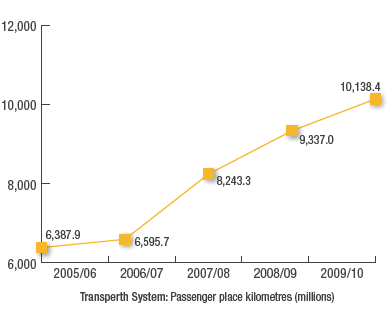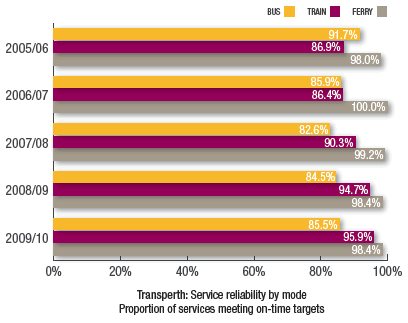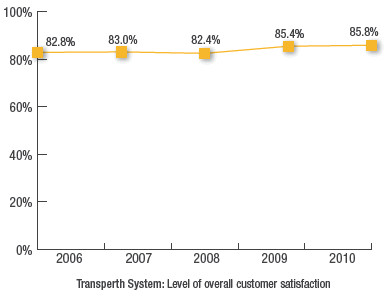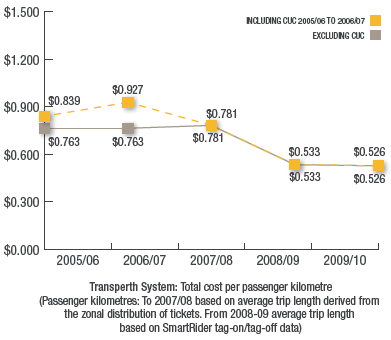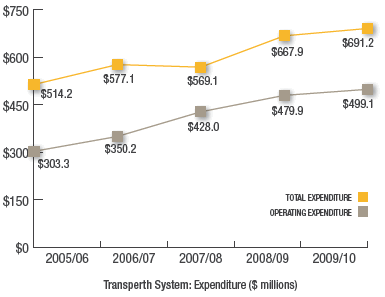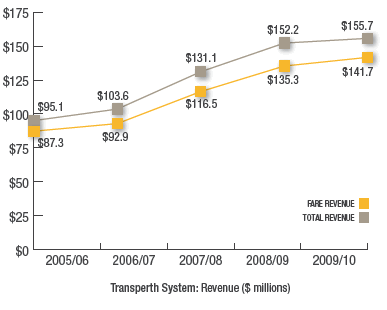Key service measures
Patronage and services
Following the extension of SmartRider-based free travel in April 2009, three categories are used to report patronage on Transperth services to ensure valid comparison over time:
- cash and SmartRider initial boardings (i.e. fare-paying cash and SmartRider boardings and free travel on SmartRider),
- total initial boardings (cash and SmartRider initial boardings plus free bus travel on Free Transit Zone and Central Area Transit services) and;
- total boardings (total initial boardings plus transfer boardings).
Free travel on SmartRider refers to travel by WA seniors and aged and disability pensioners on weekdays from 9am to 3.30pm and all day weekends and public holidays as well as all-day free travel by PTA current and some retired staff and train travel within the Free Transit Zone by SmartRider users. Previously (since June 1999), WA Seniors Card holders were entitled to free travel on Sundays and public holidays.
Patronage on the Transperth system increased in 2009/10 though the rate of growth declined compared with the previous two years. Cash and SmartRider initial boardings increased 1.6 per cent compared with increases of 13.7 per cent and 10.1 per cent in 2008/09 and 2007/08 respectively. Total boardings increased by 2.2 per cent compared with increases of 18.4 per cent and 7.8 per cent in the previous two years.
Free travel by seniors and pensioners amounted to 4.623 million initial boardings and 7.276m total boardings in 2009/10. In the three months to June 30, seniors and pensioners recorded 1.201m initial and 1.922m total boardings, an increase of 14.4 per cent and 21.9 per cent respectively over initial boardings of 1.050m and total boardings of 1.577m in the same three-month period in 2009.
The following chart shows cash and SmartRider initial boardings (which correspond to fare-paying boardings reported previously) and total boardings over the five-year period to 2009/10. Initial boardings (cash ticket sales and paid and free SmartRider initial boardings) rose 1.6 per cent to 78.852m in 2009/10 compared with 77.605m in 2008/09. Total boardings recorded an increase of 2.2 per cent to 131.629m in 2009/10 from 128.784m.
Passenger place kilometres - which represent the total passenger-carrying capacity of the Transperth bus, train and ferry network - also increased substantially. This metric is based on service kilometres and the average capacity of the fleet.
In 2009/10, passenger place kilometres rose 8.6 per cent to 10,138.4m following increases of 13.3 per cent in 2008/09 and 25 per cent in 2007/08. In the five-year period from 2005/06, total capacity provided on the Transperth system has increased by 58.7 per cent.
This big jump in capacity was due to the expansion of the Transperth train network which more than doubled between 2005/06 and 2009/10. The extension of the network to Clarkson and Thornlie, the introduction into service of three and six-car trains and the increase in service kilometres following the start of services on the Mandurah Line resulted in train passenger place kilometres increasing 53.4 per cent to 4600.8m in 2007/08 from 2998.3m in 2006/07. Following the introduction of new services, a further increase of 22.6 per cent to 5641.3m was recorded in 2008/09. In 2009/10, train passenger place kilometres increased by 14.4 per cent to 6456.2m.
The contribution of the bus network to passenger carrying capacity growth was modest. In 2009/10, bus passenger place kilometres fell 0.4 per cent to 3677m following a 1.5 per cent increase in 2008/09.
Access to public transport
The graph shows that a very high proportion of Property Street Addresses (PSAs) in the Perth Public Transport Area (PPTA) are within walking distance (500m) of a Transperth stop providing an Acceptable Service Level (ASL). An ASL is defined as a 20-minute or better service in the peak flow direction during the peak and at least an hourly service throughout the core of the day.
Transperth uses Global Positioning System (GPS) data to measure the level of accessibility to public transport facilities. The exact location of all bus stops and train stations is identified and accessibility to these facilities is measured against other spatial data - in this case PSAs.
In 2010, 82.9 per cent of PSAs in the PPTA were within 500m of a stop providing an ASL, up 2.2 per cent from 81.1 per cent in 2009. While the number of PSAs in the PPTA increased by 2.7 per cent to 863,460 in 2010 from 840,731, PSAs within walking distance of an ASL stop increased 4.9 per cent to 715,719 from 681,989. In the five years to 2010, the number of PSAs within walking distance of Transperth facilities providing an ASL increased by 34.5 per cent from 524,054 in 2006 to 715,719.
The significant improvement in the level of PSA access to Transperth facilities resulted from the expansion of the feeder bus network in the southern suburbs following the introduction of the Mandurah Line. This is reflected in the rapid increase in the number of ASL stops between 2007 and 2008 from 5969 to 6698 (12.2 per cent) and to 7279 in 2009 (8.7 per cent). The rate of increase in the number of ASL stops slowed to 0.4 per cent in 2010 when a total of 7309 was recorded.
Reliability
The OTR of Transperth bus and ferry services is measured by the GPS Reporter functionality of the SmartRider ticketing system; for trains through the train control system. These technology-based monitoring methods allow more precise data-gathering than the physical checks and manual observations used previously.
In 2009/10, buses and trains recorded improvements in service reliability. On buses, 85.5 per cent of services met the OTR criteria, up from 84.5 per cent in 2009, while trains achieved a reliability level of 95.9 per cent compared with 94.7 per cent in 2009. The Transperth ferry service maintained its OTR rate unchanged at 98.4 per cent.
Passenger satisfaction
An independent market research firm commissioned by Transperth carries out the annual Passenger Satisfaction Monitor (PSM) to assess the level of satisfaction/dissatisfaction among passengers in regard to various aspects of Transperth services. This graph shows the proportion of respondents who expressed overall satisfaction with the quality of service on Transperth bus, train and ferry operations, calculated as the weighted average across all modes.
In 2010, 85.8 per cent of users across the system expressed overall satisfaction with the quality of service compared with 85.4 per cent 2009. It is noteworthy that following a relatively static level of satisfaction from 2006 to 2008, a significant improvement was achieved in 2009 and this level of satisfaction was maintained in 2010.
Passenger safety
Note: Measures relating to customer perception of safety at other times and at stations/interchanges are shown in sections dealing with individual modes.
The PSM assesses customer perceptions of safety during the day and at night, aboard buses, trains and ferries and at bus and train stations and ferry jetties. This chart shows that virtually all passengers felt safe aboard Transperth buses, trains and ferries during the day.
Efficiency
In 2009/10, total cost per passenger kilometre for the Transperth system fell 1.4 per cent to $0.526 from $0.533 in 2008/09. This result was achieved despite a 3.5 per cent increase in total expenditure, because of a 4.9 per cent increase in passenger kilometres.
The significant reduction in this cost figure from $0.781 in 2007/08 is due to a change in the method of determining the average trip length.
Since 2008/09, SmartRider tag-on/tag-off data has been used to calculate the average trip length for bus and train passengers. The tag process provides a precise basis for the calculation as it accurately records the length of each journey leg on both initial and transfer boardings.
Initial boardings comprise fare-paying boardings (cash and SmartRider) and the free travel available to some SmartRider users - seniors, aged and disability pensioners, veterans, PTA current and some retired staff and train travel within the Free Transit Zone (FTZ) - as well as bus travel within the FTZ and on Central Area Transit (CAT) services in Perth, Fremantle and Joondalup and on the Midland Shuttle.
The average trip length determined for SmartRider users is then applied to cash initial and transfer boardings. Estimated trip lengths are applied to boardings on bus services in the FTZ and boardings on CAT services and the Midland Shuttle.
Until 2007/08, the calculation of the average trip length was based on the zonal distribution of ticket sales/validations. Calculating 2007/08 passenger kilometres using an average trip length based on SmartRider tag-on/tag-off data results in a total cost per passenger kilometre of $0.535 for 2007/08, 31.5 per cent less than the reported figure of $0.781.
Expenditure and revenue
Total expenditure on Transperth services was $691.172m in 2009/10, up 3.5 per cent compared with $667.886m in 2008/09. Operating expenditure (excluding capital charges) rose 4.0 per cent to $499.108m from $479.941m. Capital charges recorded an increase of 2.2 per cent to $192.064m from $187.945m. Across the modes, bus total costs increased by 5 per cent and operating costs by 5.5 per cent, while train total costs increased by 2.2 per cent and operating costs by 2.3 per cent. For the ferry, total costs rose 25.9 per cent and operating costs 15.7 per cent - due to the expenditure of $74,000 to refurbish the MV Shelley Taylor-Smith.
The increase in system costs in 2009/10 was due mainly to:
- Higher maintenance cost of B-series railcars
- Expenditure on modifications to A-series railcars
- Increase in bus driver wages
- Higher operating costs arising from the increasing use of gas buses
- Increase in bus service kilometres operated during the year.
The increasing trend in revenue continued in 2009/10 although at a lower rate than previously. Fare revenue increased by 4.8 per cent while total revenue rose by 2.3 per cent.
Fare revenue includes full or part funding for CAT services, contributions for the provision of specific bus services, joint ticketing revenue (where the public transport fare is included in the price of the event ticket), Commonwealth funding for concession travel by interstate seniors and income from the sale of SmartRider cards. Total revenue takes into account, in addition to fare revenue, other income comprising advertising, rent, infringements etc.
The reduction in fare-paying boardings following a full year of the free travel period for seniors and pensioners did not impact significantly on fare revenue. The overall decline of 3.1 per cent in system fare-paying boardings was offset by the 3.9 per cent average increase in standard fares (concession and student fares were unchanged).
In regard to individual modes, bus recorded a 5.1 per cent decline in fare-paying boardings but had a 1.8 per cent increase in fare revenue. On train, fare paying boardings fell by just 0.5 per cent but fare revenue recorded a 5.6 per cent increase. Ferry suffered losses in both fare-paying boardings and fare revenue.
The lower rate of increase in total revenue (2.3 per cent) was due to the 18 per cent reduction in other income, from $16.954m in 2008/09, to $13.924m.

